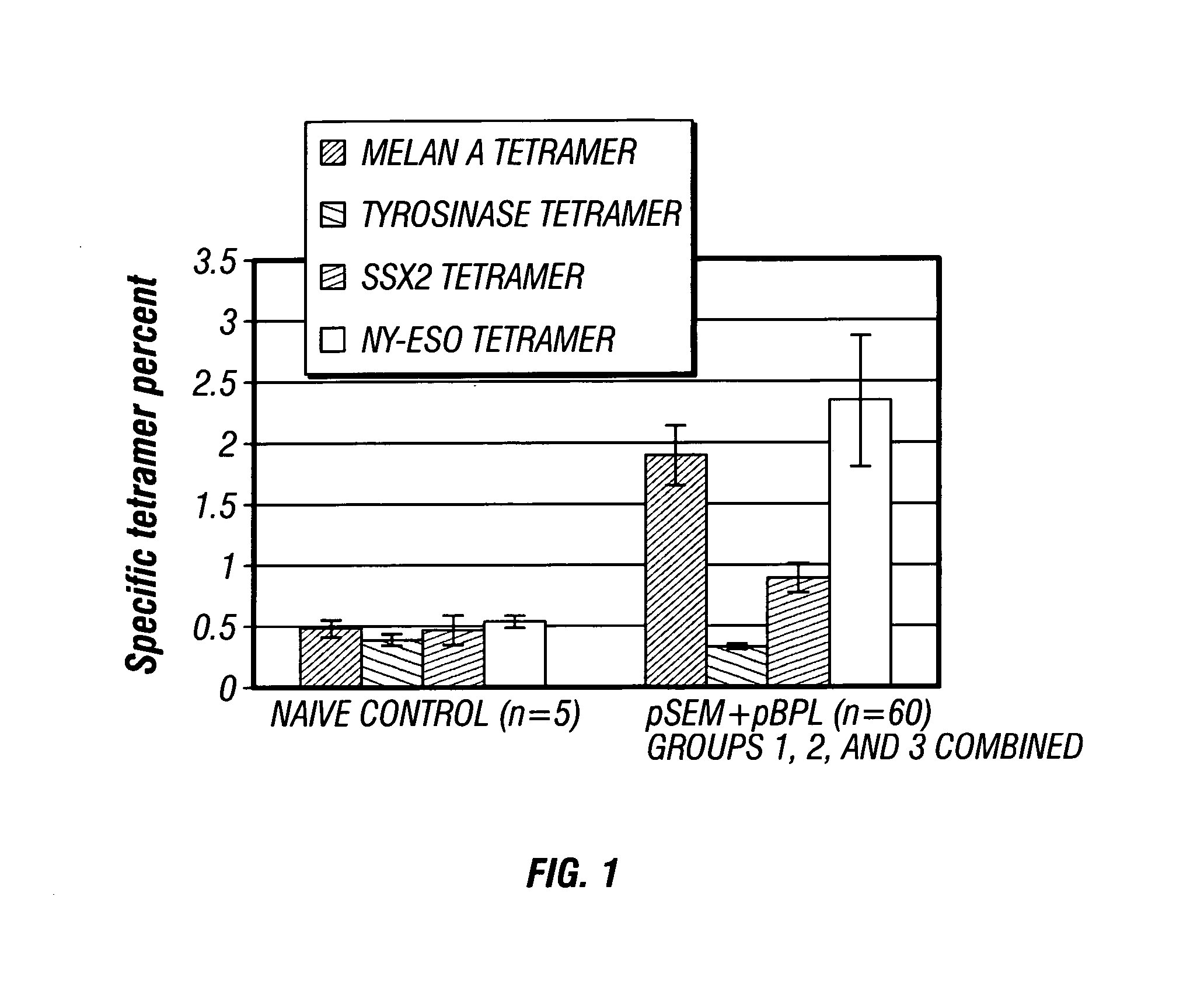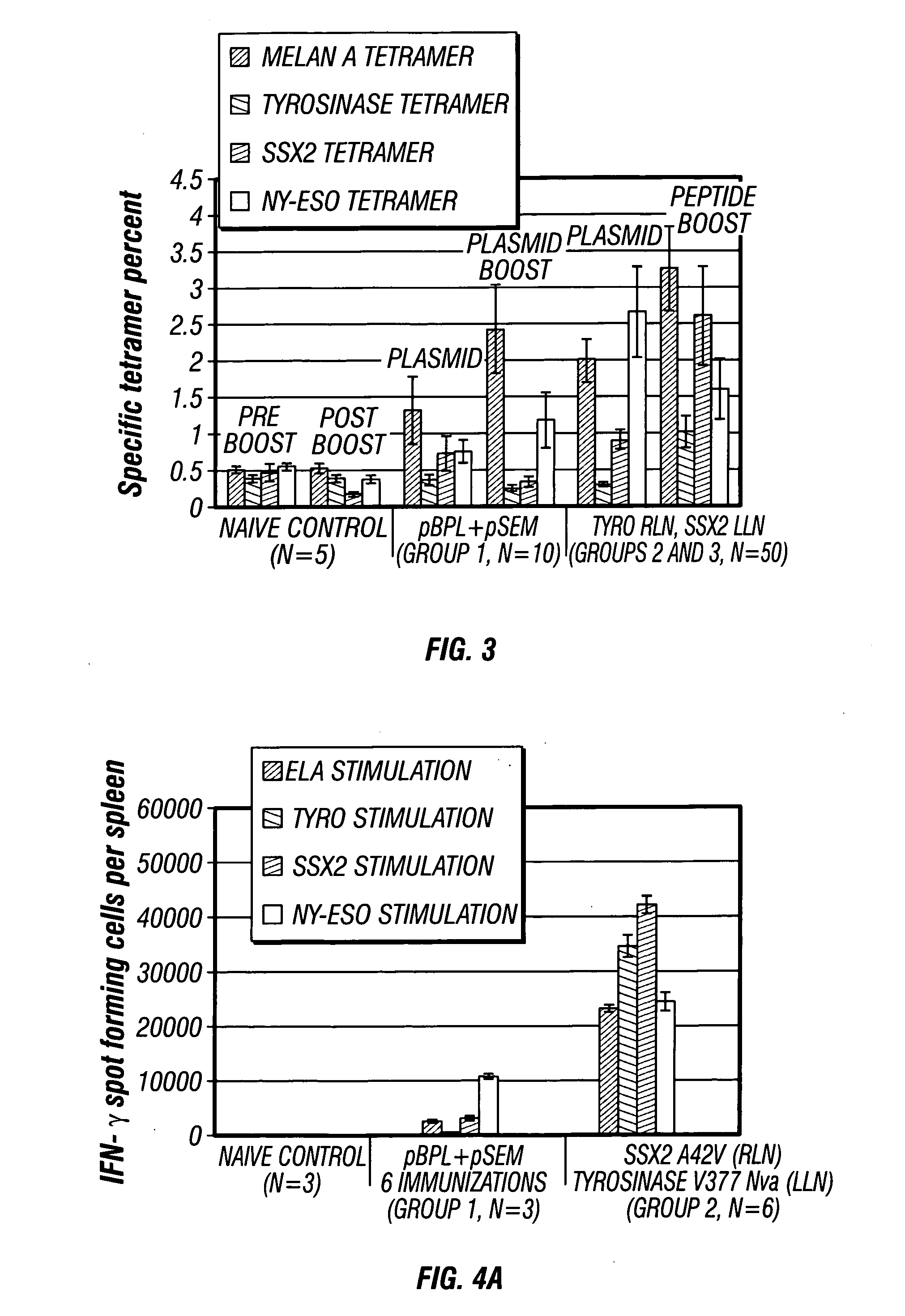Multivalent entrain-and-amplify immunotherapeutics for carcinoma
a cancer and immunotherapy technology, applied in the field of multivalent response, can solve the problem that the host's neoplastic cells generally appear to be ignored by the host's
- Summary
- Abstract
- Description
- Claims
- Application Information
AI Technical Summary
Benefits of technology
Problems solved by technology
Method used
Image
Examples
example 1
Experimental Procedure
Animals
[0094] Since the immune response against human T cell epitopes cannot be studied in original nonclinical models due to the inherent MHC-restriction of immunity, a genetically manipulated mouse model was chosen that expresses the human A*0201 gene (Pascolo et al., 1997), which is frequently expressed in the human population. In contrast to immune deficient mice (the basis for xenograft models), the A*0201 transgenic model (HHD) is immune competent, thus allowing the evaluation of active immunotherapeutic strategies.
[0095] Therefore, female H-2 class 1-negative (knockout) HLA-A2.1-transgenic HHD mice, 8-12 weeks of age, were used in these studies. The animals were housed under pathogen-free conditions.
Methodology
[0096] The bivalent pSEM plasmid (non-replicating recombinant DNA) encoding for the tumor-associated antigens Melan-A26-35 (SEQ ID NO. 9) and Tyrosinase369-377 (SEQ ID NO. 10) and pBPL bivalent plasmid encoding for tumor-associated antigens ...
example 2
Immunization with Plasmids pSEM and pBPL Prior to Peptide Boost
[0106] The purpose of this study was to determine whether immunization with the plasmids pSEM and pBPL could induce a tetravalent response against the four tumor associated antigens SSX-241-49 (SEQ ID NO. 1), NY-ESO-1157-165 (SEQ ID NO. 2), Melan-A26-35 (SEQ ID NO. 9) and Tyrosinase369-377 (SEQ ID NO. 10).
[0107] Three groups of female HHD animals (H-2 class I-negative (knockout) HLA-A2.1-transgenic HHD mice, 8-12 weeks of age) were immunized with a mixture of pSEM / pBPL (100 μg / day) to the bilateral inguinal lymph nodes. Group 1 (n=10 mice) received plasmid injections on Days 1, 4, 15, 18, 28, 32, 49, and 53; Group 2 and Group 3 (n=25 mice per group) received plasmid injections on Days 1, 4, 15, and 18 respectively (Table 2; above). On day 25, blood was collected from the immunized animals, and CD8+ T cell analysis was performed using a tetramer assay as discussed elsewhere herein. Responses were compared to naïve litte...
example 3
Individual Immunization with Plasmid Primed SSX-2 / Tyrosinase
[0109] It was assessed whether boosting with the subdominant epitope peptides alone following plasmid priming was sufficient to achieve a tetravalent immune response. Therefore, animals from Group 2 above, were boosted with the sub-dominant epitopes, tyrosinase V377Nva (SEQ ID NO. 12) and SSX-2 A42V (SEQ ID NO. 5) peptide analogues and immune responses were compared to a naïve control.
[0110] Animals were primed with a plasmid mixture of pBPL+pSEM on days 1, 4, 15, and 18 (100 μg / day) in bilateral inguinal lymph nodes followed by a peptide boost consisting of SSX-241-49 A42V (SEQ ID NO. 1) in the left lymph node and Tyrosinase369-377 V377Nva (SEQ ID NO. 12) on in the right lymph node on days 28 and 32 (25 μg / day). On day 39, seven days following the last peptide injection, blood was collected from the immunized animals, and CD8+ T cell analysis was performed using a tetramer assay as discussed elsewhere herein.
[0111]FIG. ...
PUM
| Property | Measurement | Unit |
|---|---|---|
| concentration | aaaaa | aaaaa |
| concentration | aaaaa | aaaaa |
| concentration | aaaaa | aaaaa |
Abstract
Description
Claims
Application Information
 Login to View More
Login to View More - R&D
- Intellectual Property
- Life Sciences
- Materials
- Tech Scout
- Unparalleled Data Quality
- Higher Quality Content
- 60% Fewer Hallucinations
Browse by: Latest US Patents, China's latest patents, Technical Efficacy Thesaurus, Application Domain, Technology Topic, Popular Technical Reports.
© 2025 PatSnap. All rights reserved.Legal|Privacy policy|Modern Slavery Act Transparency Statement|Sitemap|About US| Contact US: help@patsnap.com



